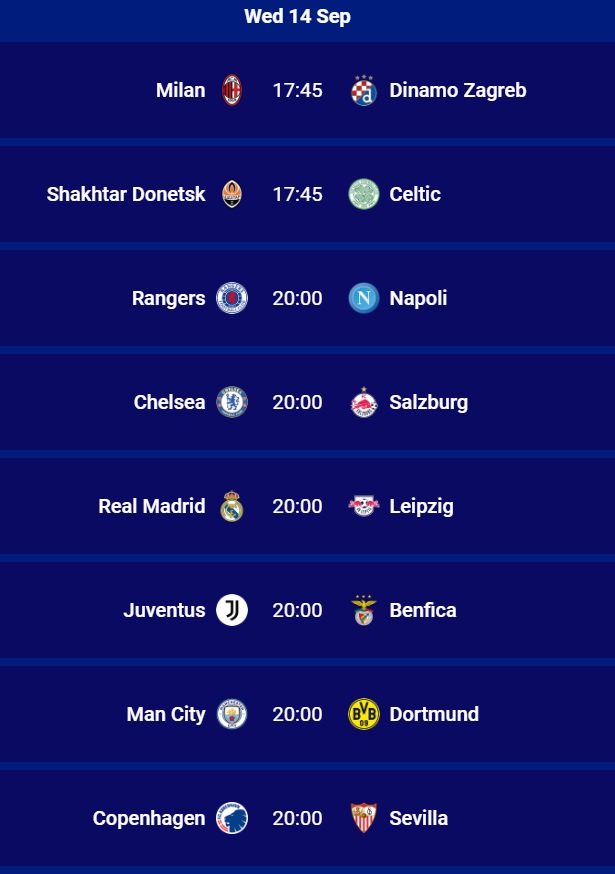
Beyond the Scoreline: Unpacking the UEFA Champions League Matchday Statistical Landscape
The UEFA Champions League, football’s premier club competition, is a tapestry woven with moments of breathtaking skill, strategic genius, and raw emotion. While the scoreline ultimately dictates triumph and despair, it merely scratches the surface of the intricate narratives unfolding on the pitch. Beneath the goals and glory lies a rich vein of data – a statistical universe that reveals the tactical battles, individual brilliance, and collective efficiencies defining each matchday. For the astute observer, analysts, and even casual fans, delving into these numbers offers an unparalleled understanding of what truly transpired and what might lie ahead.
This article aims to provide a comprehensive statistical summary of a typical UCL matchday, exploring key metrics across offensive prowess, defensive solidity, midfield dominance, individual contributions, and tactical trends. We will not merely list numbers but interpret their significance, painting a clearer picture of the beautiful game at its highest level.
I. Offensive Prowess: The Quest for Goals
Goals are the currency of football, and the Champions League consistently delivers a high-octane offensive spectacle. A typical UCL matchday, encompassing 8 to 16 matches depending on the stage (group stage usually features 16 matches over two days), offers a fascinating look at attacking output.
Average Goals Per Game: Historically, the Champions League averages around 2.8 to 3.2 goals per game. This figure reflects the high quality of attacking talent and the inherent risk-taking nature of elite European football. Teams are often willing to commit players forward, leading to more open games and scoring opportunities. A matchday might see this average fluctuate slightly, with some days witnessing a flurry of goals (e.g., 40+ goals across 16 games) and others being tighter affairs.
Shot Volume and Efficiency:
- Total Shots: Top teams often register 15-20 shots per game, while their opponents might manage 8-12. However, sheer volume isn’t everything.
- Shots on Target (SoT): The ratio of shots on target to total shots (often around 30-40%) is a crucial indicator of a team’s attacking precision. A high SoT percentage, even with fewer overall shots, can signal effective chance creation.
- Conversion Rate: This metric, calculated as goals scored per shots on target, reveals a team’s clinicality. Elite forwards often boast conversion rates upwards of 25-30%, meaning roughly one in three or four of their shots on target finds the back of the net. A matchday summary will highlight teams that were exceptionally clinical or, conversely, those who squandered numerous opportunities.
Expected Goals (xG): A more advanced metric, xG quantifies the probability of a shot resulting in a goal based on factors like shot location, body part used, and defensive pressure. A matchday’s xG summary can reveal whether a team’s goals were a result of genuine high-quality chances or perhaps a stroke of luck (overperforming their xG). Conversely, a team that created a high xG but scored few goals might be considered unlucky or lacking in finishing quality.
Goal Types:
- Open Play: The vast majority of goals come from open play, showcasing fluid attacking moves, quick transitions, and individual dribbling.
- Set Pieces: Corners, free-kicks, and penalties contribute significantly. A matchday often sees 20-30% of goals originating from set-piece situations, highlighting the importance of specialized routines and aerial prowess.
- Counter-Attacks: Teams proficient in quick transitions often net goals from counter-attacks, exploiting space left by opponents. Statistics on "fast breaks" or "direct attacks" can illuminate this aspect.
II. Midfield Mastery & Ball Control: The Engine Room
The midfield is the battleground where possession is contested, tempo is set, and creative sparks ignite. Statistical analysis of midfield play reveals much about a team’s philosophy and control.
Possession Percentage: This is perhaps the most widely cited statistic. Top European clubs often aim for 60% or more possession, dictating the flow of the game. However, possession without purpose can be sterile. A matchday summary will show a spectrum, from possession-dominant teams (e.g., Barcelona, Manchester City) to those comfortable playing with less of the ball, focusing on defensive solidity and quick breaks (e.g., Atlético Madrid, certain counter-attacking Bundesliga sides).
Passing Metrics:
- Total Passes: A high volume of passes indicates a team’s commitment to ball retention and intricate build-up play. Elite teams often complete 500-700+ passes per game.
- Passing Accuracy: Crucial for maintaining possession and breaking down defenses. Across a matchday, successful teams typically achieve 85-90% passing accuracy. Midfielders, especially deep-lying playmakers, often boast even higher percentages (92-95%).
- Forward Passes & Key Passes: These metrics highlight intent and creativity. Forward passes aim to break lines, while "key passes" are those that lead directly to a shot. A matchday’s top performers in key passes are often the creative maestros, the architects of attacking moves.
- Long Passes & Crosses: While short passing dominates, effective long passes (for switching play or finding attackers in space) and accurate crosses (especially from full-backs and wingers) are vital offensive weapons.
Duels Won: Midfield battles are often decided by individual duels – ground duels (tackles, interceptions) and aerial duels. A high percentage of duels won indicates a team’s physical dominance and ability to regain possession. Midfield enforcers and defensive midfielders often lead their teams in this category.
III. Defensive Fortitude & Goalkeeping Excellence
While offense wins games, defense wins championships. A robust defensive unit is the backbone of any successful Champions League campaign.
Clean Sheets: The ultimate defensive achievement, a clean sheet means preventing the opposition from scoring. A matchday summary will highlight which teams kept their opponents scoreless, often indicative of strong defensive organization or a dominant performance.
Defensive Actions:
- Tackles Won: The number of successful tackles demonstrates a team’s ability to dispossess opponents.
- Interceptions: Reading the game and cutting off passing lanes is vital. High interception numbers point to intelligent defensive positioning.
- Clearances: Removing danger from the penalty area, especially under pressure, is a fundamental defensive task.
- Blocks (Shots & Passes): Sacrificing one’s body to block shots or key passes can be as crucial as a save, preventing dangerous situations.
Goalkeeper Performance:
- Saves Made: The number of saves a goalkeeper makes is a direct measure of their busyness.
- Save Percentage: This metric (saves divided by shots on target faced) is a more refined indicator of a goalkeeper’s performance, showing their efficiency in stopping shots that reach the goal. A world-class keeper typically has a save percentage of 70% or higher.
- Successful Exits/Catches: Goalkeepers’ command of their penalty area, especially during crosses and set pieces, is vital for relieving pressure.
IV. Discipline & Fair Play: The Tactical Edge
Football is a physical game, and discipline plays a crucial role, influencing not just the current match but also future availability of key players.
Fouls Committed & Suffered:
- Fouls Committed: Teams with a high number of fouls might be employing a high-pressing, aggressive style, or struggling to contain their opponents.
- Fouls Suffered: Players who are frequently fouled are often dangerous dribblers or key playmakers who need to be stopped by illegal means.
- Yellow & Red Cards: These direct consequences of fouls or unsporting conduct have immediate and long-term impacts. A matchday summary will highlight teams with disciplinary issues, as accumulated yellow cards lead to suspensions, weakening a squad for crucial future encounters.
Offsides: While seemingly minor, offsides can indicate a team’s defensive line discipline (catching attackers offside) or, conversely, an attacking team’s lack of timing or poor communication.
V. Individual Brilliance: Beyond the Team
While statistics primarily reflect team performance, individual metrics highlight the standout players who often turn the tide of a match.
- Top Scorers & Assisters: These lists are always prominent, showcasing the most potent attacking talents.
- Most Dribbles Completed: Identifies players capable of beating opponents one-on-one, creating space and disrupting defensive structures.
- Most Tackles/Interceptions: Highlights the defensive workhorses and midfield destroyers.
- Most Chances Created: Similar to key passes, but often encompasses more creative actions.
- Passing Accuracy (Individual): Often highlights central midfielders or defenders who are pivotal in ball retention and build-up.
- Distance Covered: While not always directly correlated with impact, it indicates a player’s work rate and stamina.
VI. Home Advantage & Tactical Trends
Statistical summaries often reveal broader patterns and tactical evolutions within the Champions League.
Home vs. Away Performance: Historically, home teams have a distinct advantage in football, and the UCL is no exception.
- Win Rate: Home teams typically win around 50-60% of their matches, compared to 25-30% for away teams (the rest being draws).
- Goals Scored/Conceded: Home teams generally score more and concede fewer goals.
- Possession & Shots: Home teams often dictate play more, having higher possession and more shots. The "12th man" effect of the crowd, familiarity with the pitch, and reduced travel fatigue all contribute.
Emerging Tactical Trends:
- High Pressing: Statistics like "regains in the opposition half" or "high turnovers" indicate teams employing an aggressive high press, aiming to win the ball back close to the opponent’s goal.
- Full-back Involvement: Modern full-backs are increasingly involved in attacking play. Their numbers for crosses, key passes, and even shots can be surprisingly high.
- Positional Flexibility: Players often operate in fluid roles. Statistics sometimes struggle to capture this, but the distribution of touches across different zones can offer clues.
- Impact of Substitutions: Analyzing the statistical change in a team’s performance after substitutions can reveal the effectiveness of a coach’s in-game management.
Conclusion: The Data-Driven Narrative
A UEFA Champions League matchday statistical summary is far more than a collection of dry figures. It’s a powerful narrative tool, offering an analytical lens through which to view the beautiful game. From the average goals per game to the individual duel success rates, every metric contributes to a deeper understanding of tactical successes, individual heroics, and moments of struggle.
While the raw emotion and unpredictability of football will always remain paramount, statistics provide invaluable context. They help us appreciate the nuanced strategies employed by Europe’s elite clubs, identify rising stars, and understand why certain teams dominate while others falter. For coaches, analysts, and fans alike, these numbers serve as a testament to the meticulous preparation, the relentless effort, and the sheer quality that define every single matchday in the UEFA Champions League, turning the complex symphony of football into a decipherable, data-driven story.



